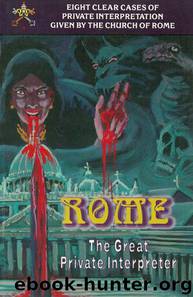ROME - The Great Private Interpreter by Dr. Peter S. Ruckman

Author:Dr. Peter S. Ruckman [Ruckman, Dr. Peter S.]
Language: eng
Format: epub, mobi
Publisher: BB Bookstore
Published: 2011-08-18T07:00:00+00:00
THE FIFTH
PRIVATE INTERPRETATION
The fifth private interpretation of Rome is in connection with the following verses from Matthew 26:
“And as they were eating, Jesus took bread, and blessed it, and brake it, and gave it to the disciples, and said, Take, eat; this is my body. And he took the cup, and gave thanks, and gave it to them, saying, Drink ye all of it; For this is my blood of the new testament, which is shed for many for the remission of sins” (Matt. 26:26–28).
Before examining the Roman private interpretation of the passage (which, as all Roman interpretation, is arrived at by either ignoring the Scriptures or misapplying the Scriptures), let us see what the Scriptures themselves have to say about the passage.
“For I have received of the Lord that which also I delivered unto you, That the Lord Jesus the same night in which he was betrayed took bread: And when he had given thanks, he brake it, and said, Take, eat: this is my body, which is broken for you: this do in remembrance of me....For as often as ye eat this bread, and drink this cup, ye do shew the Lord’s death till he come. Wherefore whosoever shall eat this bread, and drink this cup of the Lord, unworthily, shall be guilty of the body and blood of the Lord....For he that eateth and drinketh unworthily, eateth and drinketh damnation to himself, not discerning the Lord’s body” (1 Cor. 11:23–29).
“The cup of blessing which we bless, is it not the communion of the blood of Christ? The bread which we break, is it not the communion of the body of Christ? For we being many are one bread, and one body:” (1 Cor. 10:16–17).
“For by one Spirit are we all baptized into one body...” (1 Cor. 12:13).
“The church, Which is his body, the fulness of him that filleth all in all” (Eph. 1:22–23).
“Wherefore henceforth know we no man after the flesh: yea, though we have known Christ after the flesh, yet now henceforth know we him no more” (2 Cor. 5:16).
Instead of running to John 6 (a pre-crucifixion Jewish discourse) as any first-century Ebionite would do, we have quoted the exact matching and fitting passages, where the Prince of the Apostles and Chief, Paul, writing to Gentile Christians in Europe, describes the purpose and meaning of the Paschal Supper. Note that the “body of Christ” in the Pauline Epistles (where it deals with communion) is never the earthly, fleshy body of a dead Saviour—it is always and in every place a reference to the risen body of a living Lord. Furthermore, the risen body has no blood (1 Cor. 15:50; Luke 24:39), and it is composed of people who are “members of his body, of his flesh, and of his bones” (Eph. 5:30). The “body” taken at communion is a risen body of believers who have been crucified, dead, buried, and risen with Christ (Rom. 6:1–6). Not by the wildest stretch of the depraved imagination could this body be the pre-crucifixion body of a physical Jew about to be crucified.
Download
ROME - The Great Private Interpreter by Dr. Peter S. Ruckman.mobi
This site does not store any files on its server. We only index and link to content provided by other sites. Please contact the content providers to delete copyright contents if any and email us, we'll remove relevant links or contents immediately.
Resisting Happiness by Matthew Kelly(3200)
The Social Psychology of Inequality by Unknown(2771)
Designing Your Life by Bill Burnett(2605)
Day by Elie Wiesel(2599)
The Giving Tree by Shel Silverstein(2178)
Angels of God: The Bible, the Church and the Heavenly Hosts by Mike Aquilina(1871)
Human Design by Chetan Parkyn(1859)
The Supreme Gift by Paulo Coelho(1801)
Jesus of Nazareth by Joseph Ratzinger(1710)
Augustine: Conversions to Confessions by Robin Lane Fox(1688)
Hostage to the Devil by Malachi Martin(1676)
7 Secrets of Divine Mercy by Vinny Flynn(1623)
Dark Mysteries of the Vatican by H. Paul Jeffers(1607)
The Vatican Pimpernel by Brian Fleming(1588)
St. Thomas Aquinas by G. K. Chesterton(1558)
Saints & Angels by Doreen Virtue(1532)
The Ratline by Philippe Sands(1425)
My Daily Catholic Bible, NABRE by Thigpen Edited by Dr. Paul(1418)
Called to Life by Jacques Philippe(1410)
